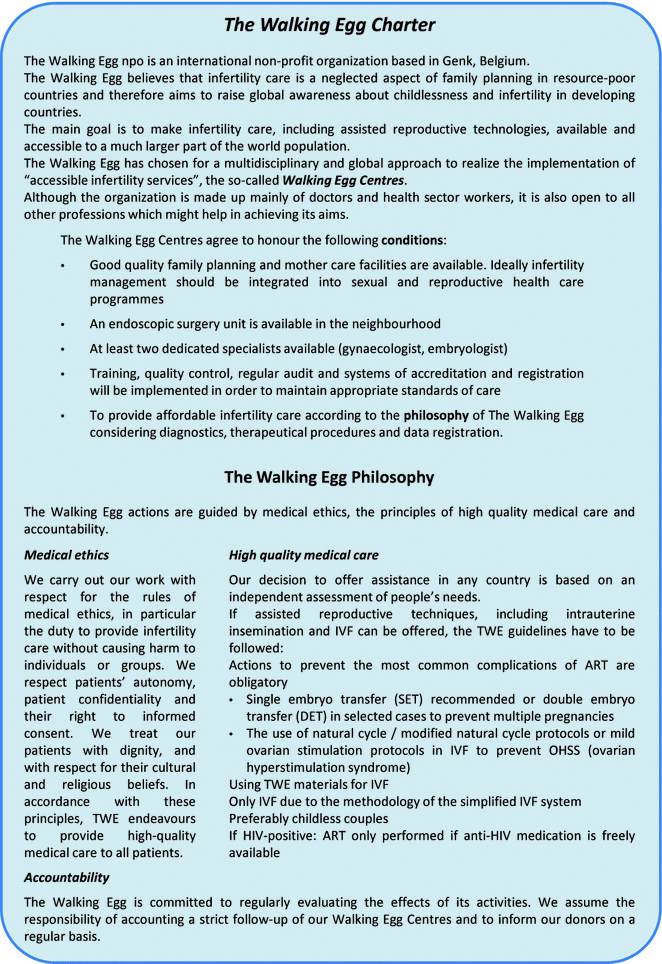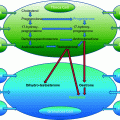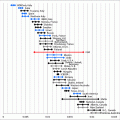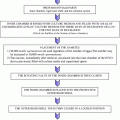Fig. 20.1
Proposed flowchart for the TWE diagnostic clinic (T WE The Walking Egg, FAM Fertility awareness methods, IUI Intrauterine insemination, NC Natural cycle, COH Controlled ovarian hyperstimulation, TI Timed intercourse, IMC Inseminating motile count) [34]
Future studies are planned to assess the reproducibility of “one-stop infertility clinics” in different developing countries.
Simplified Infertility Treatment and Non-IVF Assisted Reproduction
If tubal patency is demonstrated in ovulatory women and if severe male factor subfertility has been excluded, fertility awareness programmes are an inexpensive and efficient first-line approach to infertility management [39, 40]. Fertility awareness counselling to couples about the meaning and detection of cervical mucus secretion can be given by nurses and paramedical staff working in existing reproductive healthcare centres.
For ovulatory dysfunction, representing almost 20% of female infertility, clomiphene citrate (CC) is a very cheap and rewarding option. In case of resistance to CC, a low-dose ovarian stimulation regimen with gonadotrophins aimed at monofollicular growth is advisable, although this medication is more expensive.
In case of unexplained and moderate male factor infertility and provided tubal patency has been documented, intrauterine insemination (IUI) with husband’s semen in natural cycles or after mild stimulation is an excellent first-line treatment without major costs and without expensive infrastructure [41, 42]. IUI programmes can be run by well-trained paramedical staff, another advantage for resource-poor countries. Controlled ovarian hyperstimulation (COH), with or without IUI, is associated with the risk of multiple gestations, especially when gonadotrophins are used [43]. Appropriate standardized protocols are available to minimize the risk of multiple pregnancies which is even more important in developing countries because the consequences of multiple pregnancies can be devastating.
Simplified IVF Laboratory Procedures
Another major challenge is to reduce costs of laboratory procedures, namely fertilization and culture of eggs and embryos for IVF. Different options and approaches have been developed or are presently being field-tested with promising results.
Intravaginal fertilization and culturing have been used since many years for low-cost IVF [44]. A tube filled with culture medium containing the oocytes and washed spermatozoa is hermetically closed and placed in the vagina. It is held intravaginally by a diaphragm for incubation for 44–50 h. Over 800 cycles have been published worldwide with a very reasonable clinical pregnancy rate of almost 20% [44].
As part of The Walking Egg Project and based on the previous findings and experience [45, 46], we developed a new simplified method of IVF culturing, called the TWE-lab method. With this new system, specifically designed for low-resource settings, we can avoid the high costs of medical gases, complex incubation equipment and infrastructure typical of IVF laboratories in high-resource settings (see Addendum 1).
For insemination of the eggs, we only use 1000–10,000 motile washed spermatozoa per oocyte, with very promising results, which makes this technique usable for more the 70% of the actual IVF/ICSI population (Genk data, not published). Since development from insemination to transfer is undisturbed and in the same tube until embryo transfer, we can avoid many problems frequently occurring in regular IVF laboratories, such as unwanted temperature changes and air quality problems.
Up to April 2013, twelve healthy babies have been born after using this technique while a prospective study comparing the embryo quality after using TWE-lab versus regular IVF procedures is still ongoing.
Low-Cost Ovarian Stimulation Protocols for IVF
In order to make infertility care more affordable in developing countries, effective, cheap and safe stimulation schemes for intrauterine insemination (IUI) and in vitro fertilization (IVF) need to be established. A review of the literature clearly shows the value and effectiveness of mild ovarian stimulation protocols in ART settings [47]. The success rates of natural cycle IVF can be low per cycle due to high cancellation rates because of premature LH rise and premature ovulation. But the use of indomethacin to block ovulation helps to reduce the cancellations. Cumulative pregnancy and live birth rates after four consecutive cycles could reach 46 and 32%, respectively, making it a cost-effective, safe and patient-friendly option [48]. The use of clomiphene citrate (CC), a very cheap oral drug, has been proven in many studies to be an optimal alternative with acceptable results, minimal side effects and a very low complication rate [47, 49–51].
Monitoring of follicular development in an IVF cycle, as well as the timing of the hCG administration, can be done solely on sonographic criteria with basic inexpensive ultrasound equipment, thereby avoiding the need of expensive endocrine investigations [52].
Nevertheless, although very promising results concerning the different steps of IVF are described, we still have to perform a lot of feasibility studies to examine the value of a one-stop diagnostic phase and to study the value of the simplified TWE-lab system and different low-cost ovarian stimulation protocols in resource-poor settings.
Service Delivery: The Implementation of TWE Pilot Centres in DC
The ultimate aim of The Walking Egg project is the implementation of good quality but low-cost infertility centres in DC, if possible and preferable integrated into existing reproductive healthcare centres. Diagnostic and therapeutic procedures and protocols should be affordable, effective, safe and standardized. Ideally, infertility management should be integrated into sexual and reproductive healthcare programmes.
As developing countries differ in their status of development, three levels of assistance are suggested [53]. A level 1 infertility clinic is a basic infertility clinic capable of offering the following services: basic infertility workout including semen analysis, hormonal assays, follicular scanning, ovulation induction and IUI. In level 2 infertility clinics, IVF can be performed as well.
During many expert meetings, it was decided that level 3 infertility clinics capable of offering ICSI, cryopreservation and operative endoscopy are not part of The Walking Egg Project in the initial phase. Therefore, our first target is the implementation of good quality level 2 centres.
Implementation of level 2 services entails the following activities [53]:
- 1.
Equipping the clinics: Infertility clinics in developing countries should be provided with low-cost and easy serviceable equipment taking into consideration the local problems often encountered (e.g. fluctuating voltage, frequent power cuts, unavailability of servicing facilities, and irregular supply of consumables). This may require negotiations with various manufacturers to supply these tools at affordable prices, particularly if large quantities are ordered.
- 2.
Training the staff: This includes the training of the medical, paramedical as well as the administrative staff. Training courses should tailor to the local conditions and the possible difficulties encountered in developing countries. Table 20.1 gives an overview of the key topics covered in the training courses. Training, quality control, regular audit and systems of accreditation and registration should be implemented in order to maintain appropriate standards of care. Our objective is to organize a one-week course for all members of the team who are involved in the set-up of a pilot centre, part of The Walking Egg Project. This training will need the support of experts in the field, who are capable to tutor the training courses at the highest level in a very short time, taking into account the experience of the trainees and the quality of facilities that can be expected in the new pilot centres.
• Reproductive healthcare education basic course
—Target group: nurses, midwifes
• A general and medical history of and basic clinical examination both partners
—Clinician (medical)
• Screening for infections and STDs
—Clinician (medical, paramedical)
• How to perform and evaluate a hysterosalpingography and/or hystero-salpingo-contrast-sonography
—Clinician (medical, paramedical)
• Standard Operational Procedures for the gynaecological and fertility ultrasound scan
—Clinician (medical, paramedical)
• Basic semenology training course according to WHO 2010 manual
—Laboratory staff (paramedical)
• Sperm washing procedures
—Laboratory staff (paramedical)
• Mini-hysteroscopy
—Clinician (medical)
• Documentation and registration
—Administrative staff (clerical)
- 3.
Educating the public: This necessitates establishing contacts and working relationships with schools, community leaders, traditional healers as well as the media, producing and distributing educational materials (brochures, posters and audio-visual material) etc.
- 4.
Running the services: This should take into consideration the staff salaries, regular purchasing of consumables, cost of equipment maintenance, cost of investigations, cost of medical interventions and the cost of medication. Special servicing contracts should be negotiated with the manufacturers. In addition, simplification of the consumables should be taken into consideration, and laboratory reagents and culture media should have a long shelf life. Special prices for medication should be negotiated with the drug manufacturers, and simple treatment protocols should be put into action in order to reach the best cost-effective therapies.
- 5.
Documentation and registration: We believe that within each pilot centre, online data registration of all ART activities is mandatory. Administrative staff and (para) medicals have to be aware of the importance of correct and trustable data registration. The ultimate goal is to offer all pilot centres a similar registration programme, which should be customer-friendly with a limited but sufficient number of items (increased personnel compliancy) [34]. Continuous monitoring of service activities will be centralized and will provide feedback to clinics for clinical and laboratory policy adjustments, information to couples on clinic performance and information to society. Confidence can then be built and maintained.
- 6.
Psychological and sociocultural follow – up: When implementing low-cost (accessible) infertility services in DC, it is extremely important to study social, psychological, sexual, legal and ethical aspects of infertility and infertility treatment and take study findings into account when setting up gender and cultural sensitive infertility services. Considering psychological and sociocultural follow-up, the most important aims can be summarized as follows:
Informing the design of culture- and gender-sensitive treatment and counselling procedures, ethical guidelines and informed consent forms for the selected pilot centres.
Describing the psychological well-being of the infertile women and men along the infertility treatment trajectory (before, during, immediately and one year after treatment); their expectations, experiences and suggestions regarding treatment procedures and aspects of quality of care; and the social repercussions and other social implications infertility treatments may have.
Enhancing the level of knowledge and understanding with regard to sociocultural, psychical, quality of care and ethical aspects of infertility care in DC.
Selection of Countries/Pilot Centres
Decision-making on infertility treatment in developing countries assumes answers to quite a few questions: How should the infertility problem be defined? How often does infertility occur? What is the income in that specific country and what can be spend on health care? How cheap should IVF be in order to be accessible to a considerable part of the population? With what alternative health interventions should infertility treatment be compared? How cost-effective should IVF be in order to compete with those other interventions?
In this respect, we believe that measurements of the (utility measure-oriented) quality of life over the infertile life course in developing countries are urgently needed.
The selection of countries where the first pilot centres are implemented will be based on the following: (1) available data on the resources, needs and resource gaps for infertility services on a national level; (2) percentage of GDP spent on education and health care; (3) the availability of endoscopic surgery facilities in the neighbourhood; (4) a good quality family planning unit; (5) good quality mother care facilities; and (6) the availability of at least one experienced and dedicated gynaecologist and biologist.
The community/region including the local healthcare authorities should be empowered to support the programme from the beginning. Figure 20.2 gives an overview of The Walking Egg Philosophy and The Walking Egg Charter with the most important recommendations to consider when starting TWE pilot centres in developing countries.


Fig. 20.2
Charter and philosophy of The Walking Egg project
Selection of Patients and IVF Protocol
Decision-making on infertility treatment in developing countries assumes answers to quite a few questions: How should the infertility problem be defined? How often does infertility occur? What is the income in that specific country and what can be spend on health care? How cheap should IVF be in order to be accessible to a considerable part of the population?
In this respect, we believe that measurements of the (utility measure-oriented) quality of life over the infertile life course in developing countries are urgently needed.
The selection of centres where the first pilot centres are implemented will be based on the following: (1) available data on the resources, needs and resource gaps for infertility services on a national level; (2) percentage of GDP spent on education and health care; (3) the availability of endoscopic surgery facilities in the neighbourhood; (4) a good quality family planning unit; (5) good quality mother care facilities; and (6) the availability of at least one experienced and dedicated gynaecologist and biologist.
Stay updated, free articles. Join our Telegram channel

Full access? Get Clinical Tree







